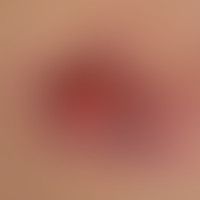Image diagnoses for "Nodule (<1cm)"
268 results with 997 images
Results forNodule (<1cm)

Angiofibroma (overview) D23.0
angiofibroma of the oral mucosa: nodularly distended angiofibroma of the oral mucosa. no signs of inflammation, no indication of malignancy. no relevant complaints. differential diagnosis is a mucosal granuloma after bite injury. image from the collection of Dr. Michael Hambardzumyan

Squamous cell carcinoma of the skin C44.-
Squamous cell carcinoma of the skin: large-nodular, locally ulcerated, locally metastasized carcinoma of the scalp.

Melanoma nodular C43.L
Melanoma, malignant, nodular, solitary, solid, sharply defined, surface smooth, non-hairy, black speckled, symptomless lump, growing for more than a year, foundduring routine examination (lump has always been there). Incident light microscopy revealed strong grey-blue streaks and massive pigment network break-ups.

Squamous cell carcinoma of the skin C44.-
Squamous cell carcinoma of the skin: approx. 3 cm in diameter, coarse, crusty, exuding tumour with an inflammatory reddening of the edges in the area of the neck of a 95-year-old female patient, which empties purulent secretion under pressure.

Keratosis seborrhoeic (overview) L82

Hordeolum H00.01
Hordeolum. solitary, acute (existing for a few days), 0.5 cm high, bulging, considerably painful, red, smooth lump with surrounding reflex erythema.

Pyogenic granuloma L98.0
Granuloma pyogenicum: fast growing, asymptomatic tumour without apparent cause; tendency to bleed with minor trauma; has been satelite for 14 days.

Collagenosis reactive perforating L87.1
Collagenosis, reactive perforating, chronically dynamic (continuous neoplasms since 1 year), 0.1-0.5 cm large, slightly itchy, rough, red, rough papules, which ulcerate centrally during growth.

Melanoma acrolentiginous C43.7 / C43.7
Acrolentiginous malignant melanoma: A brown, slowly increasing spot that has existed for years. It is said that this broad-based, ulcerated, repeatedly bleeding node has been formed for a few months. Arrows mark the non-node acrolentiginous part of the tumor. A weak pigmentation zone is encircled, which histologically also turned out to be melanoma infiltration.

Collagenosis reactive perforating L87.1

Old world cutaneous leishmaniasis B55.1

Primary cutaneous (anaplastic) large cell lymphoma cd30-negative C84.5
Lymphoma cutaneous T-cell lymphoma large cell anaplastic.

Intravascular large b-cell lymphoma C83.8
Primary cutaneous intravascular large cell B-cell lymphoma: initial nodular formation of asymptomatic, blurred, reticular surface smooth erythema; nodular formation for several months; surface eroded and bleeding.











